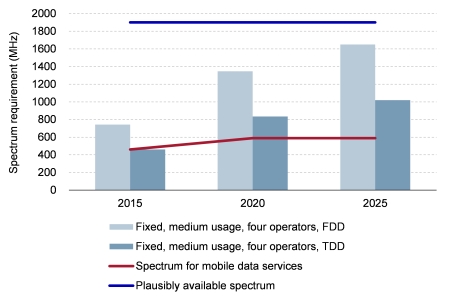Analysys Mason’s study suggests 600MHz more spectrum is required for wireless broadband services in Denmark
A study conducted for the Danish National IT and Telecom Agency (NITA) by Analysys Mason’s consulting team concludes that the Danish government will need to make at least an additional 600MHz spectrum available for wireless broadband services, to reach its target of bringing 100Mbit/s broadband to the whole country.
The report notes that because the Danish government’s broadband target is more ambitious than those of other governments (which do not require 100% of households to have access to a 100Mbit/s service), further spectrum is required.
The overall objective of the study was to determine the amount of spectrum required to deliver fixed and mobile broadband services through wireless technologies in Denmark, noting the Danish government’s broadband target and the assumption that a combination of wired and wireless networks will be needed to deliver the goal of ‘100Mbit/s everywhere’.
The estimation of spectrum requirements in the report is based on a model that evaluates mobile and fixed wireless access (FWA) spectrum demand in three different geo-types: urban, suburban and rural areas, and the spectrum requirements for a range of scenarios assuming that there is a requirement to provide a wireless substitute service to fixed broadband services delivering speeds of 100Mbit/s by 2020. In the base case (considered to be the most likely), estimates of spectrum requirements are based on assumptions that:
- 50% of households without access to 100Mbit/s fixed broadband services subscribe to a wireless alternative 100Mbit/s service
- the average data consumption of these subscribers is 25% of the consumption of the average fixed broadband subscriber.
Under these assumptions, the report finds that spectrum demand is very likely to exceed the currently planned supply of spectrum. Thus, to meet the level of demand calculated in this scenario, additional spectrum would have to be awarded, and spectrum demand could reach 1700MHz by 2025. Taking into account spectrum already used or planned to be used, this leaves around 600MHz shortfall to be met through identification of additional
bands.

Figure 1: Spectrum demand in urban areas in the assumed base case, Denmark, 2015, 2020 and 2025 [Source:Analysys Mason, 2011]
The report identified two candidate bands for particular consideration to meet the additional spectrum requirement: the 1.5GHz and 2.3GHz bands. The report also discusses the need for more spectrum below 1GHz, identifying spectrum in the 700MHz range (adjacent to the European 800MHz band) as a possible candidate.
Latest Publications
Article
New thinking on spectrum valuation is needed for upper mid-band frequencies
Article
Why spectrum renewal policy matters for network investment and service quality
Article
Does the mobile market need additional sub-1GHz spectrum?

